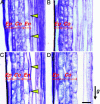Shoot circumnutation and winding movements require gravisensing cells
- PMID: 16339910
- PMCID: PMC1310508
- DOI: 10.1073/pnas.0504617102
Shoot circumnutation and winding movements require gravisensing cells
Abstract
Circumnutation and winding in plants are universal growth movements that allow plants to survive despite their sessile nature. However, the detailed molecular mechanisms controlling these phenomena remain unclear. We previously found that a gravitropic mutant of Japanese morning glory (Pharbitis nil or Ipomoea nil), Shidare-asagao (weeping), is defective not only in circumnutation but also in the winding response. This phenotype is similar to that of the Arabidopsis SCARECROW (SCR) mutant. We therefore investigated whether morning glory SCR (PnSCR) is involved in the weeping phenotype. We found that one amino acid was inserted into the highly conserved VHIID motif in weeping-type PnSCR; this mutation caused abnormal endodermal differentiation. We introduced either the mutant or WT PnSCR into Arabidopsis scr mutants for complementation tests. PnSCR of the WT, but not of weeping, rescued the shoot gravitropism and circumnutation of scr. These results show that both the abnormal gravitropism and the circumnutation defect in weeping are attributable to a loss of PnSCR function. Thus, our data show that gravisensing endodermal cells are indispensable for shoot circumnutation and the winding response and that PnSCR is responsible for the abnormal phenotypes of weeping.
Figures





Comment in
-
Up, down, and all around: how plants sense and respond to environmental stimuli.Proc Natl Acad Sci U S A. 2006 Jan 24;103(4):829-30. doi: 10.1073/pnas.0510471102. Epub 2006 Jan 17. Proc Natl Acad Sci U S A. 2006. PMID: 16418288 Free PMC article. No abstract available.
Similar articles
-
The gravity-regulated growth of axillary buds is mediated by a mechanism different from decapitation-induced release.Plant Cell Physiol. 2008 Jun;49(6):891-900. doi: 10.1093/pcp/pcn063. Epub 2008 Apr 17. Plant Cell Physiol. 2008. PMID: 18420594
-
[Development of endodermal cells and expression of SCARECROW gene in weeping mutant of morning glory (Pharbitis nil)].Biol Sci Space. 2001 Oct;15(3):248-9. Biol Sci Space. 2001. PMID: 11997626 Japanese. No abstract available.
-
Gravity perception and gravitropic response of inflorescence stems in Arabidopsis thaliana.Adv Space Res. 1999;24(6):763-70. doi: 10.1016/s0273-1177(99)00410-x. Adv Space Res. 1999. PMID: 11542620
-
The endodermis and shoot gravitropism.Trends Plant Sci. 1999 Mar 1;4(3):103-7. doi: 10.1016/s1360-1385(99)01376-x. Trends Plant Sci. 1999. PMID: 10322541 Review.
-
Role of endodermal cell vacuoles in shoot gravitropism.J Plant Growth Regul. 2002 Jun;21(2):113-9. doi: 10.1007/s003440010047. Epub 2002 May 24. J Plant Growth Regul. 2002. PMID: 12024223 Review.
Cited by
-
Fine mapping of the gene controlling the weeping trait of Prunus persica and its uses for MAS in progenies.BMC Plant Biol. 2022 Sep 24;22(1):459. doi: 10.1186/s12870-022-03840-1. BMC Plant Biol. 2022. PMID: 36153492 Free PMC article.
-
Plant Gravitropism: From Mechanistic Insights into Plant Function on Earth to Plants Colonizing Other Worlds.Methods Mol Biol. 2022;2368:1-41. doi: 10.1007/978-1-0716-1677-2_1. Methods Mol Biol. 2022. PMID: 34647245 Review.
-
Altered gravitropic response, amyloplast sedimentation and circumnutation in the Arabidopsis shoot gravitropism 5 mutant are associated with reduced starch levels.Plant Mol Biol. 2008 May;67(1-2):57-69. doi: 10.1007/s11103-008-9301-0. Epub 2008 Feb 8. Plant Mol Biol. 2008. PMID: 18259878
-
Petiole hyponasty: an ethylene-driven, adaptive response to changes in the environment.AoB Plants. 2011;2011:plr031. doi: 10.1093/aobpla/plr031. Epub 2011 Dec 12. AoB Plants. 2011. PMID: 22476501 Free PMC article.
-
Circumnutation and distribution of phytohormones in Vigna angularis epicotyls.J Plant Res. 2018 Jan;131(1):165-178. doi: 10.1007/s10265-017-0972-y. Epub 2017 Aug 7. J Plant Res. 2018. PMID: 28785824
References
-
- Hoson, T., Nishitani, K., Miyamoto, K., Ueda, J., Kamisaka, S., Yamamoto, R. & Masuda, Y. (1996) J. Exp. Bot. 47, 513-517. - PubMed
-
- Soga, K., Wakabayashi, K., Kamisaka, S. & Hoson, T. (2002) Planta 215, 1040-1046. - PubMed
-
- Takahashi, H. (1997) Planta 203, S164-S169. - PubMed
-
- Kamada, M., Yamasaki, S., Fujii, N., Higashitani, A. & Takahashi, H. (2003) Planta 218, 15-26. - PubMed
Publication types
MeSH terms
Substances
Associated data
- Actions
LinkOut - more resources
Full Text Sources
Other Literature Sources
Molecular Biology Databases

